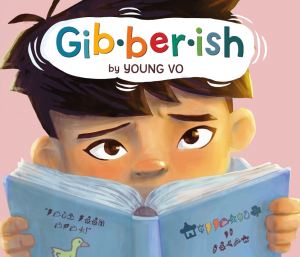 Gibberish
Gibberish
Written and illustrated by Young Vo
Levine Querido, 2022, 32 pp (unpaged)
ISBN: 978-1646141104
This picturebook highlights the dual worlds of Dat, a young boy who “sailed on a boat, then flew on a plane,” and now must encounter a new school, new expectations, and a new language that sounds like gibberish. The illustrations highlight the contrasts between Dat’s home life and school life. Classmates and teachers appear as smiling, black-and-white cartoon monsters, while Dat and his mother are portrayed realistically in full color. Tiny picture “gibberish” speech bubbles take the place of written English as Dat tries to introduce himself, only to have his name mispronounced by the bus driver and his new teacher.
Faced with all this uncertainty, Dat moves through his world almost silently, saying little but his own name. Finally, he encounters a friendly face: a small, boisterous monster who slowly morphs into a realistic, full-color girl named Julie as she teaches Dat words in English. Those who have had to learn a language in a new community will know that the frustration is reduced by the presence of a patient friend, one who will take the time to answer questions and get to know you when the teacher will not; however, it can be frustrating to feel like Dat needs to be saved.
The real power of this book is in the pictures. The visual language of video games is international and universal (dotted pathways, monsters to fight, doorways to traverse). Author Young Vo does animation for role-playing video games and those elements appear in Gibberish: Dat, as the main character, leaves a dotted pathway behind him as he moves through different monster worlds. The cartoon characters representing the English-speaking world are unsettling and the pictorial font intentionally confusing. Native English readers, trying to parse the unfamiliar font, will feel empathy for Dat’s situation. Shape and color are also imbued with meaning: when Dat is in comfortable spaces, he is surrounded by circles, while his uncomfortable moments are enclosed in boxes with sharp edges. It’s also interesting that the pictorial font actually corresponds letter-to-letter with English, and clues on the inside of the covers can help curious readers “decode” the speech in the book.
In international student forums, multilingual people recall their first experiences with English as a kind of familiar-sounding nonsense; recognizable from American music and movies but ultimately sounding like rhythmic noise mixed with the occasional word. The clever “gibberish” in this book creates a sense that understanding is close, but is out of reach for the moment. The way the world and words morph into full-color, recognizable ideas will help students understand that the confusing and unfamiliar become familiar over time.
Reading this book alongside a narrative that delves more deeply into the main character’s thoughts and feelings would allow for strong comparisons and learning. Possible choices are Bao Phi’s (2017) A Different Pond or The Day Saida Arrived by Susana Gómez Redondo (2015). For more language play and experience with disorienting language, read with Carson Ellis’ (2016) Du Iz Tak?.
Author Young Vo came to the United States as a young child and a refugee. Based in Baltimore, he has been an animator for digital games. According to an interview with Politics and Prose linked on his website, his own sketches and English picturebooks were a way to connect when he didn’t understand the language, and he remembers that the “language barrier fell away when you just talk and play together.” He wanted to create a book for “the Dats and the Julies.” Gibberish is his first book for children.
Jana Maiuri, University of Arizona, Tucson
© 2023 by Jana Maiuri

